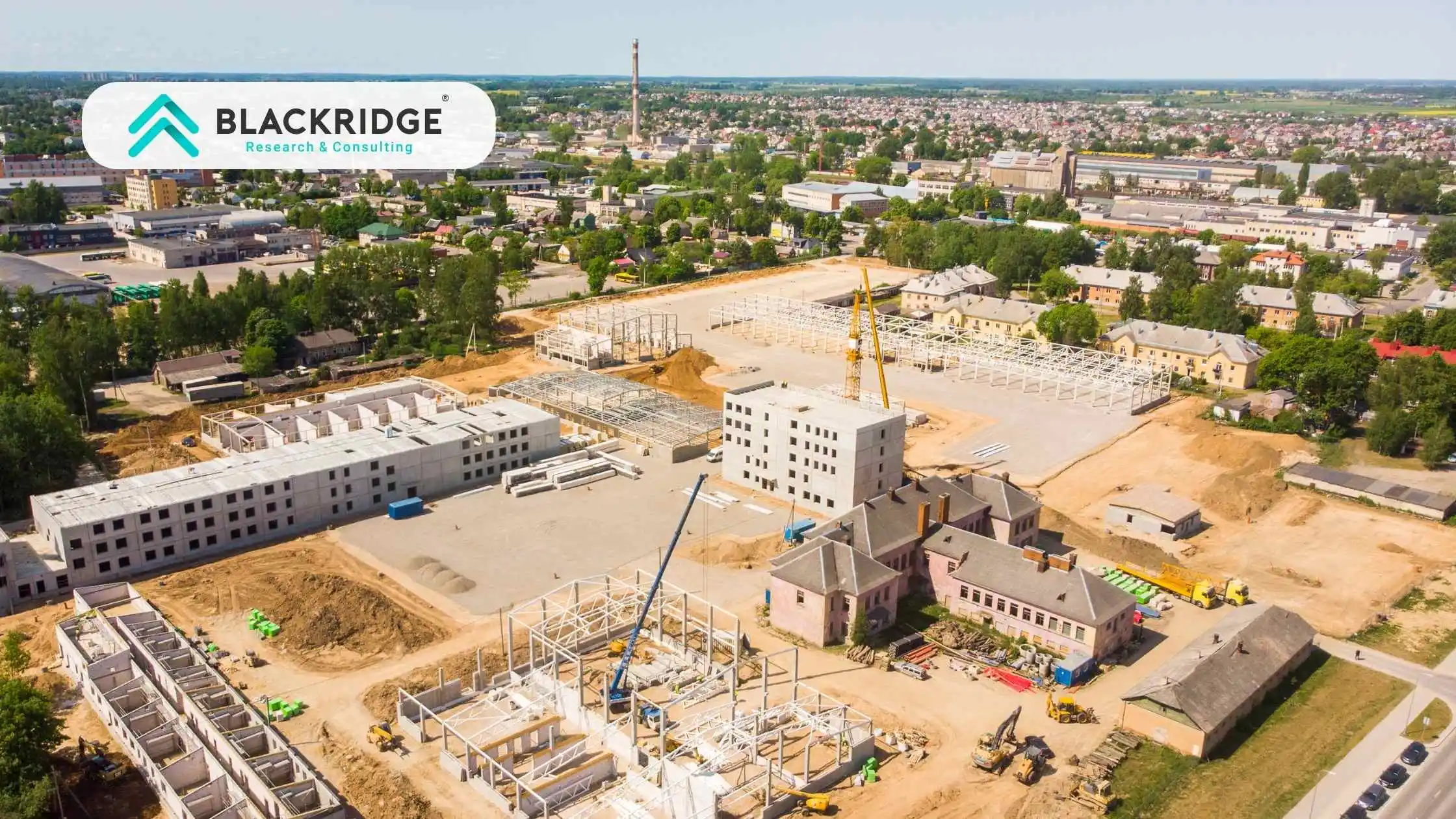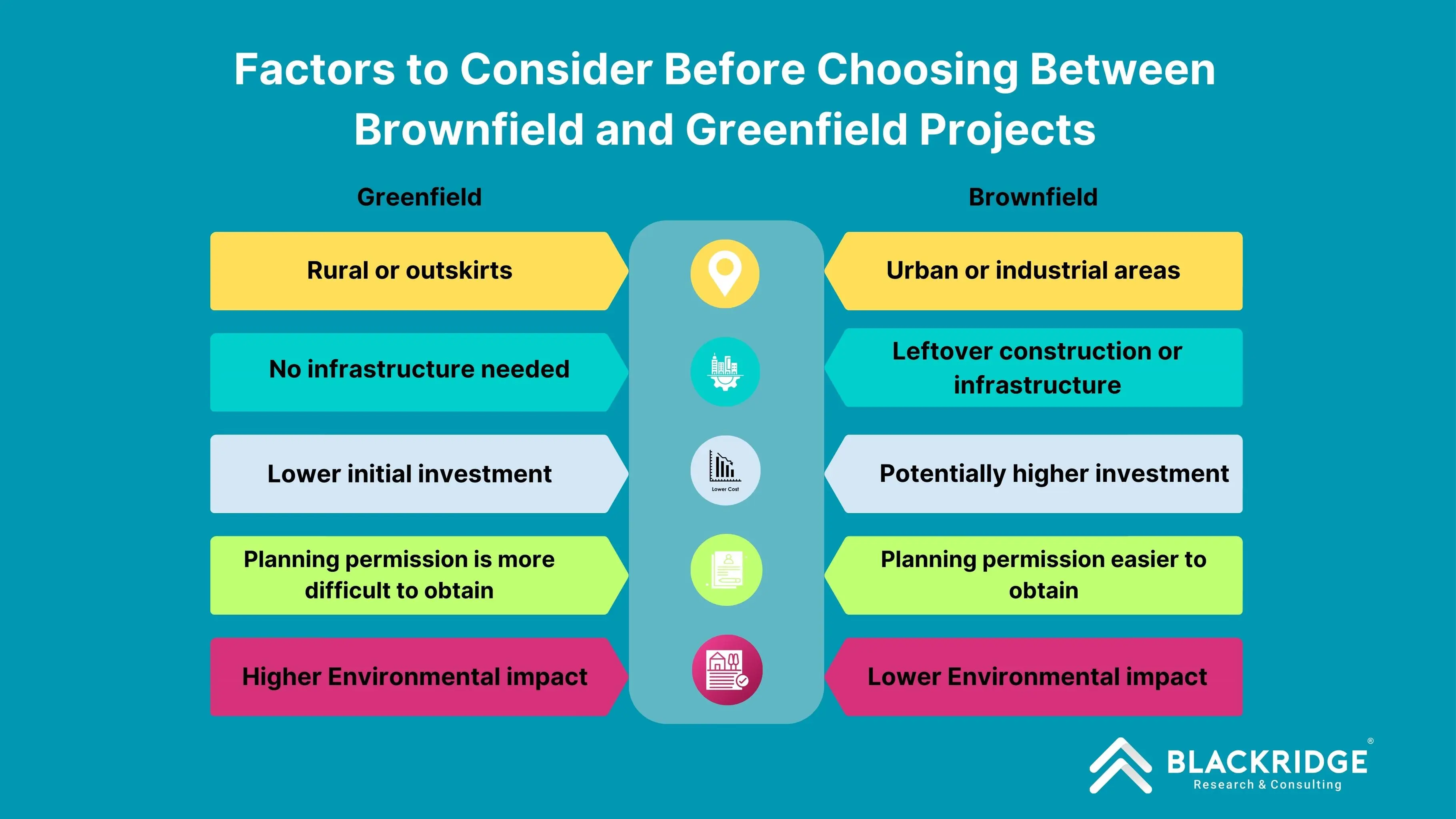Table of Contents
Greenfield vs brownfield projects differ in approach; greenfield project involves building new infrastructure on undeveloped land, but brownfield upgrades existing sites. Let’s decode this in a simple sense, when a project developer chooses a site for an upcoming data center, public infrastructure, or renewable energy project, they must decide between a “greenfield site” or “brownfield site”.
If the developer selects a previously undeveloped land, it is classified as a greenfield project. And, if the project is on a redevelopment or upgrade of sites that have been previously used for industrial or commercial purposes, that is called a brownfield project.
Differences between brownfield and greenfield projects are not limited to the site, and they differ in budget, construction time, and environmental impact. In this blog, we explore the difference between greenfield and brownfield projects, greenfield and brownfield approaches in public-private partnerships (PPP), data centers, and the energy sector.
What is a Greenfield Project?

Greenfield construction project representation
A greenfield project is a development of a new infrastructure on previously undeveloped land. In this context, the term "greenfield" signifies a clean slate. The unused land for industrial or commercial purposes provides the opportunity to start fresh without the limitations imposed by existing structures. A Greenfield implementation is common across various sectors, including energy, IT, and real estate.
What Defines Greenfield Projects:
New Development
Flexibility in Design
Sector Versatility
Regulatory Compliance
What are the Benefits of the Greenfield Project?
The companies focus on several reasons when deciding to build a new facility. You should go through these benefits of the Greenfield approach:
The Greenfield development offers flexibility in your design.
Projects will be free from the legacy constraints of old infrastructure.
Greenfield investing provides you with long-term strategic value and avoids the limitations imposed by any legacy system.
The latest technology is used in greenfield developments to ensure optimal performance and facilitate future expansion.
40+ reviews
Find the Latest Construction Industry Projects Around the World with Ease
Gain exclusive access to our industry-leading database of construction industry project opportunities with detailed project timelines and stakeholder information.
Collect Your Free Leads Here!
No credit cardUp-to-date coverage
Joined by 750+ industry professionals last month
What Challenges Do Greenfield Projects Face?
Are you aware of the challenges of greenfield sites? Read on:
Securing undeveloped land can be complex due to competition, zoning restrictions, and lengthy permitting processes.
Infrastructure requirements are high in greenfield land, and developers must build utilities, roads, and other essential services from scratch.
Greenfield developments have to clear thorough environmental impact assessments.
Urban planning can add complexity and delays to greenfield projects.
Higher upfront costs compared to brownfield projects.
Greenfield Strategy and Methodology
Greenfield strategy is a business expansion approach where a company enters a new market from zero. This includes building infrastructure, systems, and teams from scratch. This helps the investors to tailor operations, branding, and customer experience to meet specific market demands. It is often used when businesses expand into foreign markets or launch new product lines.
In project management, the greenfield migration method means creating new projects without relying on pre-existing frameworks. A greenfield deployment helps businesses to adopt the latest technology, ensuring that the project is free from outdated infrastructure. Agile methodologies are often employed to manage risks, improve communication, and ensure iterative progress throughout the project lifecycle.
What is a Brownfield Project?

Brownfield project
Brownfield projects involve the redevelopment or upgrading of previously used industrial sites. These sites will be underutilized, abandoned former industrial zones. This brownfield approach allows top construction companies to revitalize underutilized areas and make them suitable for new development. In Brownfield investment, the companies will look for available buildings that can be turned into productive spaces for their business.
What are the Benefits of Brownfield Development?
Brownfield sites offer a variety of benefits to developers. Let’s take a look into these benefits before preparing for a brownfield land development:
Brownfield implementation is mainly focused on reusing previously used land, reducing the need to expand into undeveloped green spaces.
Brownfield construction can clean up contaminated sites and mitigate pollution.
Brownfield investments can enhance property values, create jobs, and stimulate economic growth.
Short project timelines and low construction costs are the attractions for brownfield projects.
Governments often provide financial incentives and grants for brownfield redevelopment.
What Challenges Do Brownfield Projects Face?
Brownfield projects not only have benefits but also come with certain disadvantages. The challenges brownfield projects face are:
Environmental remediation is one of the biggest challenges in cleaning up the contamination from previously existing buildings.
Lengthy approval processes and strict environmental regulations.
Clean up efforts can increase the cost.
Brownfield deployment requires addressing community concerns about pollution, safety, and the impact on local neighbourhoods.
Existing structure or infrastructure may limit design options.
Greenfield vs Brownfield: Key Differences
Feature | Greenfield Project | Brownfield Project |
Land Use and Development | Developing on previously undeveloped land | Redeveloping previously used sites |
Costs and Timeframes | Higher upfront costs, faster implementation | Lower land acquisition costs, longer timelines, and potential expenses |
Risk and Complexity | Lower risks, but must navigate regulations | Higher complexity due to contamination and environmental assessments |
Environmental and Regulatory Considerations | Must comply with zoning and environmental impact assessments | Require rigorous remediation and compliance with specific regulations |
Greenfield and brownfield projects differ in certain aspects, mainly in land use and development, costs and timeframes, risk and complexity, and environmental considerations.
Greenfield projects involve developing on previously undeveloped land, offering design flexibility but typically higher upfront costs, while brownfield projects focus on redeveloping existing industrial sites, often with lower land costs but increased complexity due to environmental remediation. Greenfield developments face fewer regulatory challenges, whereas brownfield projects require extensive compliance measures.
Examples of Brownfield Vs Greenfield in Various Sectors
Brownfield Vs Greenfield approaches are the same across different sectors, but there are distinctions when dealing with specific concepts. When we focus on oil and gas exploration, we focus on large infrastructures and the production of crude oil. However, it will be different with data centers and software development. Let’s dive into each sector:
Brownfield vs Greenfield in Oil and Gas
In the oil and gas sector, greenfield exploration refers to the discovery and development of new oil fields. This oil and gas exploration gives access to untapped oil reserves, employs advanced exploration technologies, and constructs modern infrastructure from the ground up. They offer the potential for long-term production but come with high upfront investment and exploration risks.
Brownfield exploration focuses on optimizing production from existing oil fields. This involves upgrading aging infrastructure and implementing enhanced oil recovery techniques. Brownfield projects often have lower exploration risks and require less initial capital compared to greenfield projects. For example, the brownfield projects in North Sea oil fields can effectively maximize resource extraction by modernizing existing infrastructure and improving recovery processes.
Greenfield vs Brownfield Data Centers and Servers
Greenfield servers and data centers are entirely new infrastructure built in a new facility.
This allows organizations to design and implement some of the largest data centers in the world with the latest technology, optimized layouts, and modern systems. A greenfield data center built from scratch can incorporate cooling systems, power management, and modular designs, enabling more efficient technology deployment.
40+ reviews
Find the Latest Data Center Facility Projects Around the World with Ease.
Gain exclusive access to our industry-leading database of data center project opportunities with detailed project timelines and stakeholder information.
Collect Your Free Leads Here!
No credit cardUp-to-date coverage
Joined by 750+ industry professionals last month
Brownfield servers and data centers involve upgrading or retrofitting existing facilities with new technology. This approach leverages existing infrastructure, often requiring less upfront investment compared to greenfield projects. Brownfield data center projects often focus on modernizing outdated systems within an existing facility to improve performance, energy efficiency, and capacity.
Greenfield vs Brownfield in the IT Sector
In Information technology, brownfield and greenfield approaches vary from software tools, apps, websites, and networks to IT infrastructure.
Brownfield IT projects like adding a new module to a current CMS, integrating new features to an e-commerce platform, or improving the performance of an existing app come under brownfield software development. While brownfield projects offer a quicker time to market, developers often need help with legacy systems, outdated code, or incomplete documentation.
In contrast, greenfield IT projects allow for greater flexibility and innovation. Since it was developed from scratch, it will be future-proof and free of redundant dependencies of old systems. Greenfield software development projects offer greater flexibility, as they involve building new applications or systems from scratch, free from the limitations of pre-existing frameworks.
Greenfield vs Brownfield in Public-Private Partnerships (PPP)
In Public-Private Partnerships (PPP), greenfield projects involve developing new infrastructure with investments covering design, build, finance, operate, and maintain (DBFOM) phases. These projects often require more financing and carry higher risks since the infrastructure is not yet operational.
Brownfield projects, on the other hand, focus on existing infrastructure that has already been built and is operational. They involve lower risk due to established performance data and typically shorter timelines. In terms of financing, brownfield PPPs may attract more conservative investors, while greenfield projects demand higher risk tolerance due to the uncertainty of new construction.
In Public-Private Partnerships (PPP), some projects may adopt a bluefield approach, combining the development of new infrastructure with the renovation of existing assets. This hybrid approach can reduce costs while allowing for modernization.
Factors to Consider Before Choosing Between Brownfield and Greenfield Projects
Several key factors will influence your decision when deciding between a brownfield or greenfield project.

Conclusion: Choosing the Right Approach – Greenfield or Brownfield?
The choice between a greenfield or brownfield project depends on various factors such as land availability, costs, project timelines, environmental impact, and design flexibility. Greenfield projects offer the advantage of building from scratch with fewer legacy constraints but come with higher costs and longer lead times. Brownfield projects have less expensive upfront and involve environmental remediation and limitations due to existing infrastructure. Ultimately, selecting the right approach requires a careful assessment of your project's specific goals, sector requirements, and investment strategy.
Be the First to Know Exclusive Details About Construction Industry Projects Around the World!
Subscribe to our Global Construction Industry Database and unlock:
Comprehensive project details on planned, upcoming, ongoing, and commissioned construction projects
Timely updates on tenders and new developments
Access to key stakeholders and decision-makers
Market insights and future trend analysis by experts
Stay ahead with timely updates and developments in the Global construction sector by subscribing to Blackridge’s Global construction project database!
Why Blackridge’s Global Projects Tracker?
Blackridge’s Global Projects Tracker covers projects from 150 countries and is updated with real-time, accurate, and authentic project developments. By subscribing to our Global construction project database, you can get access to key contact details of ongoing and upcoming projects, project timelines and overviews, and regular alerts on project developments, all served to you through an easy-to-use interface.







Leave a Comment
We love hearing from our readers and value your feedback. If you have any questions or comments about our content, feel free to leave a comment below.
We read every comment and do our best to respond to them all.